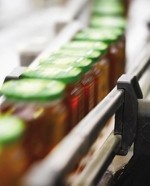Efficiency, not a logjam

There's not a food manufacturer in the country that isn't trying to rein in costs.
However, when purchasing pumps, too many are seduced by the attractive price tags of Asian-manufactured models, according to Juan Mejia, European sales and marketing director with circumferential piston pump manufacturer Wright Pump.
"Companies don't focus on the long-term view, but focus on the initial capital outlay, which is only a fraction of the overall cost of a pump," he explains. "If you buy a poor quality pump and it breaks down, the resulting downtime can cancel any saving made."
His view is shared by Ashley Shepherd, UK sales manager with Watson-Marlow: "Firms are looking for short-term payback and low-cost equipment. But a cheap product ultimately costs the user in terms of maintenance."
There are plenty of ways to cut the costs associated with pump operations, which don't involve compromising on the pump.
Pumps can be centrifugal, progressing cavity (PC), lobe, hose, peristaltic, positive deplacement, piston, gravity feed, air-driven or vacuum. For some applications, while several of these pump types might be suitable, one may offer a significant cost advantage.
Move to peristaltic pumps
For example, Watson-Marlow reports an increase in interest from food firms looking to replace air-driven pumps with peristaltic ones.
"The cost of air has risen significantly, forcing manufacturers to look at this area as a means of reducing costs," says Shepherd.
There are other indirect cost savings that can be made by deploying peristaltic pumps in certain applications, such as when metering flavourings or pumping waste process water.
For flavour or ingredient dosing, Shepherd says the pump's ability to totally enclose the pumped media within the tube ensures product integrity, while the ability to sustain volumetric accuracy, irrespective of changes in viscosity, ensures consistent dosing. At the end of a shift, or when flavourings are changed, the pumps are reversed to scavenge the lines and can return residual product to the mixing kettles, saving waste and therefore money.
Sump pumps are often used for industrial effluent but, according to Shepherd, are unreliable and a breakdown can cause damage through flooding and lost revenue in downtime. Debris blockage may cause overflow.
"We encourage the food industry to use peristaltic pumps. They are reliable and can cope with debris without blocking," he says.
This may be, but one of the problems is that manufacturers don't know enough about pumps to make informed decisions.
This came out in a survey commissioned by Mono NOV, which found that 50% of manufacturers were unaware that PC pumps could deliver cost savings. Instead, most firms were often making do with centrifugal pumps.
However, Mono NOV says centrifugal pumps cannot deal with shear-sensitive products.
"Due to a high running speed, they are not advised for shear-sensitive products such as yoghurt, cream and soups. They often have poor suction capability and therefore require priming before they can be used so hygiene problems can occur if the product has to be kept in the pump to keep it fully primed at all times," points out the company's Keith Driver.
He says that high viscosity products such as yoghurts can be easily handled by PC pumps.
This is shown by an installation Mono NOV completed at Bakemark, a UK producer of frozen bakery products and ingredients.
Bakemark had had high wear rates on its lobe pumps when transferring high viscosity icing. Mono NOV supplied two Helios hygienic processing cavity pumps with inverter drives, which meant speed could be tailored to viscosity and abrasive characteristics.
The pumps transfer icing at rates of between 1.0 and 5.3m3/h to intermediate bulk containers. They are already said to be resulting in higher production rates due to improved suction and wear characteristics.
With very viscous products, historically, firms were forced to reheat the product drum or vessel to enable the contents to be removed, says Stewart Johnson of Kecol Pumping Systems. Kecol's positive displacement pumps can transfer the product in its cold state, improving productivity and saving energy.
Kecol designed and built two Megaprime pneumatic drum emptying pump systems for transferring jam from one-tonne bulk containers at rates of up to 60kg per minute for a major breakfast cereal manufacturer. Kecol says the pumps have sped up production, improved product quality and reduced wastage.
Seepex also advocates PC pumps. "When we compare the running costs with compressed air or vacuum systems we can offer an advantage," says the firm's Lesley Eaton.
Seepex has carried out numerous projects in the brewing and distilling industries in which compressed air systems have been replaced.
Irish Distillers, part of Pernod Ricard, produces Jameson and other whiskey brands.
The process involves transferring spent grain from the lauter tun to the feed's recovery plant. Traditionally, expeller units and volumes of uncontrolled compressed air are used to handle the spent grain but this consumes a lot of energy and can restrict productivity.
Due to demand for its flagship brand, the distillery needed to increase the mashes from 30 to 45 per week. After plant modifications and upgrades were implemented the final bottleneck identified was the spent grain handling system and the time needed to empty the lauter tun, which averaged 55 minutes.
Seepex recommended replacing the air expeller units with a BT open hopper PC pump. Over the last 12 months the Seepex pumps have averaged a transfer time of 22 minutes, enabling the distillery to meet its target of 45 mashes per week. Productivity has increased by 50% and reductions in cycle time and air consumption have saved money.
Besides being sure you've got the right type of pump, it's important that it's the right size.
"We always recommend a pump that will run at a reasonable speed and have a degree of extra capacity," says Cliff Warne, UK internal sales manager with AxFlow. "In this way, the pump is never overworked and should provide a long life. Other suppliers may use a smaller pump that runs faster as a lower initial cost solution. The problem is that if you double the speed, you quadruple the wear on the pump."
Power to the pumps
When pump supplier Grundfos audited Unilever's UK ice cream plant, it found the pumps in operation too powerful for the task.
Grundfos surveyed some 600 pumps and 10 supply systems. This highlighted many sources of energy waste, such as over-pumping, valving back, oversized pumps and inefficient motors.
The 37kW single-speed pumps supplying the process water were running constantly, and the flow was controlled by valving back the water. The audit concluded that they were costing over £16,000 a year to operate.
Reducing motor size to 15kW meant that even a fixed speed pump could be operated at less than half the cost. To further increase savings by 20%, Unilever opted to install variable speed pumps, which provide greater control over the process and need only operate at a running speed of 45Hz. The payback period for the new pumps was 12 months.
Picking pumps that are easy to maintain and clean is another way of minimising the costs.
"We and other manufacturers have put a lot of effort into designing pumps that are EHEDG [European Hygienic Engineering & Design Group] certified for cleanability," says Mejia. "That's important because if you're cleaning you're not producing. Also, there is less risk that bacteria will enter and cause wastage."
Wright Pump has brought in cleaning-in-place compatibility, sealed for life gear boxes and stainless steel components.
Other suppliers have been busy in this area. Seepex has launched SST (Smart Stator Technology) which allows a stator to be changed without dismantling associated pipework. AxFlow has introduced a new hygienic pump for applications where a gentle action is required. Called the PV4, the pump features a large gap between the clamped area of the diaphragm and the liquid chamber wall. This means product particles can't get wedged in this area, eliminating a factor that can cause contamination. Also from AxFlow, the Blackmer Mouvex C-Series pump does not require mechanical seals. This is particularly beneficial when pumping products which are prone to crystallising on seal faces, as this leads to seal failure and pump leakage. FM
KEY ContactsAxFlow 020 8579 2111 Grundfos 01525 850000 Kecol Pumping Systems 0161 9800453 MonoNOV 0161 214 2381 Seepex UK 01530 415517Watson-Marlow 01326 370370 Wright Pump 00 49 89 410 799 38














